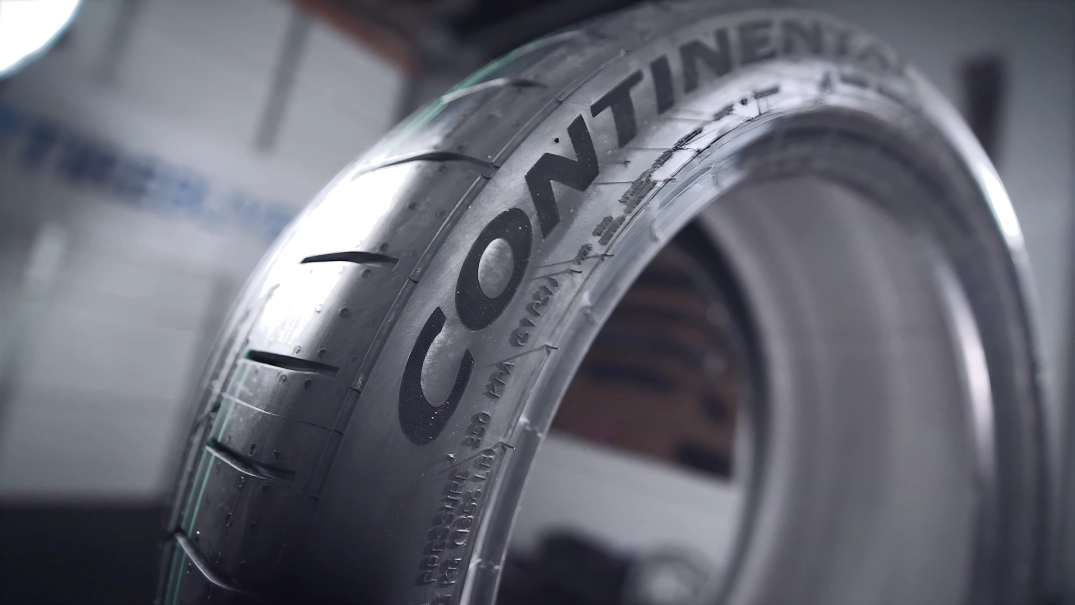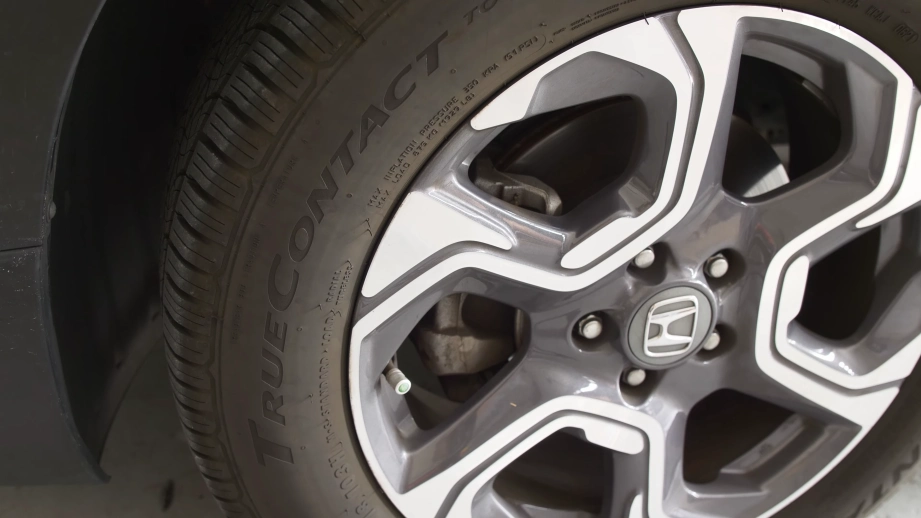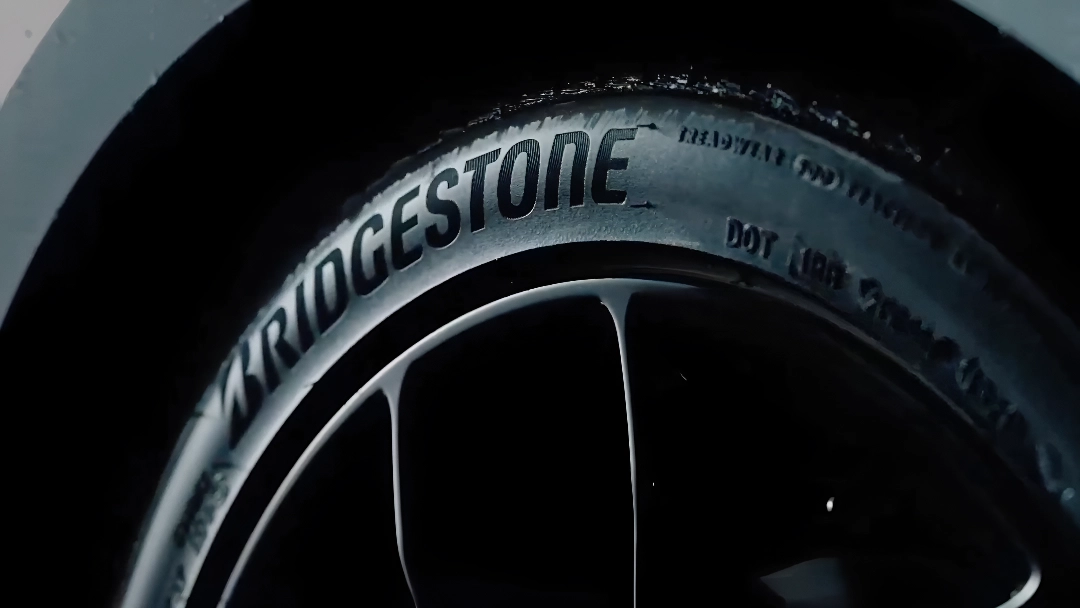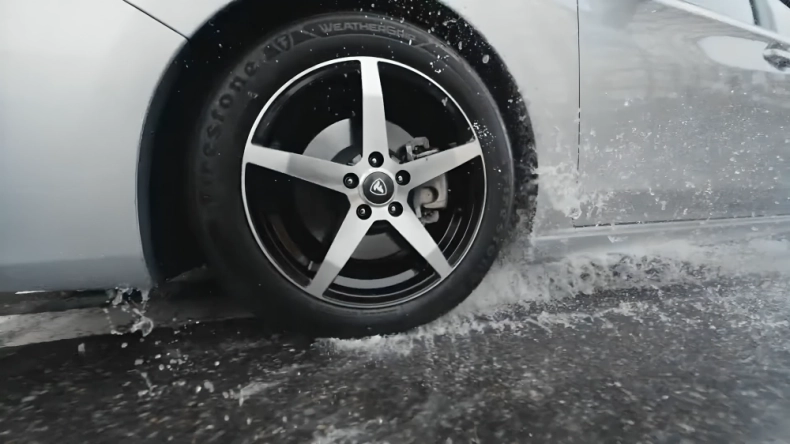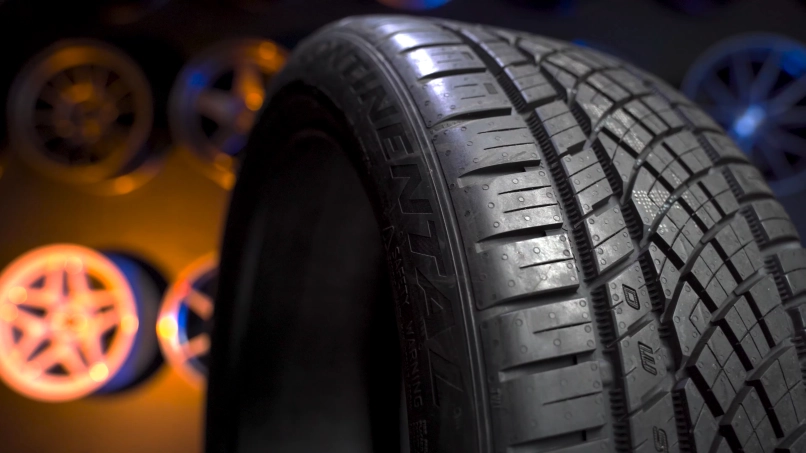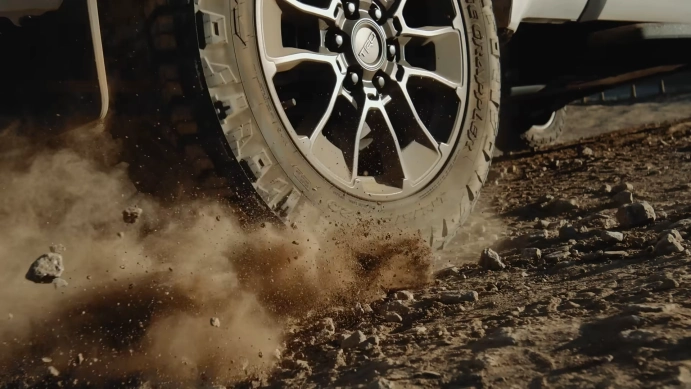
- Up to 30,000-mile limited manufacturer tread life coverage
- Engineered with Continental's SportPlus Technology for responsive handling, stellar grip on dry and wet roads plus a long tread life
- Short braking distances in both wet and dry weather
- Stellar tread life
- Preferred tire of ROUSH Performance, AMG Driving Academy, and more
If you’re after surgical-level responsiveness in tight turns, unwavering confidence when roads get slick, and refined comfort at highway speeds, the Continental ExtremeContact Sport doesn’t just perform—it demands to be driven. Engineered with cutting-edge technology and real-world durability, this ultra-high-performance (UHP) summer tire transforms everyday drives into thrilling experiences. In this review, we’ll explore how its lineage, materials, and design choices converge to deliver a tire that excels from backroad blasts to autobahn sprints.
Continental ExtremeContact Sport: Brief History
Introduced in 2015 as the successor to Continental’s SportContact series, the ExtremeContact Sport capitalized on Continental’s decades of motorsport innovation. Continental’s heritage began in the early 1900s, but it wasn’t until supplying post-war racing teams that it built its reputation. By the 1990s, Continental was synonymous with premium performance tires, balancing comfort, longevity, and driving dynamics.
The SportContact line, launched in the early 2000s, showcased Continental’s ability to craft tires that endured high-speed loads both on the street and track. As sports cars grew more powerful and track days surged, Continental recognized the need for a truly UHP summer tire. Thus, the ExtremeContact Sport was born—merging “Black Chili” compound technology (proven in DTM racing) with advanced tread design and reinforced internal structures.
By 2018, it had earned a strong reputation for striking the perfect balance between sharp handling, confident wet grip, and impressive tread life that surprised many drivers.
Today, it’s factory-fitted on many sports sedans and coupes—BMW M340i, Chevrolet Camaro SS, Mercedes-AMG C43—earning acclaim for track-capable grip, daily-driver civility, and a price point that undercuts many rivals.
Now that we’ve uncovered the roots of the ExtremeContact Sport, let’s explore the innovative engineering that transformed this tire into a modern performance benchmark.
Technologies and Construction
Black Chili Compound
At the core of its prowess lies Continental’s Black Chili compound—a silica-rich polymer blend refined through motorsport R&D. It integrates thermoplastic elastomers, nano-silica particles, and specialized polymer chains to optimize grip, heat resistance, and rolling resistance.
Under cornering loads, the molecular structure creates micro-pores that increase bite without sacrificing stability. Dynamic vulcanization ensures a robust silica-rubber interface, cutting hysteresis (energy loss) and reducing rolling resistance by roughly 8–10% versus the outgoing SportContact 6.
In wet conditions, the hydrophilic silica absorbs moisture, keeping the compound pliable to form more micro-contact points. Carbon black arrays and polymer cross-links reinforce the compound against abrasion, yielding a UTQG rating of 300 AA A—impressive for a performance tire. The result is a compound that balances dry lap times with extended tread life, two traits that often conflict in this category.
Tangential Traction Grooves & Adaptive Sipe Design
The ExtremeContact Sport features wide, circumferential center grooves to channel water rapidly away from the contact patch. Flanking these are Tangential Traction Grooves—angled lateral channels that feed water into primary evacuation paths while preserving block rigidity. This tri-groove design delays hydroplaning onset, even at speeds above 80 mph in heavy rain.
Complementing these grooves is the Adaptive Sipe Design: zigzag sipes that open under light loads to bite into wet surfaces, then collapse under higher cornering forces to stabilize the block and maintain steering precision.
Each sipe ends in a “stone ejector” notch to prevent debris buildup, ensuring consistent wet traction deep into service life. Full-depth sipes extend to the wear bars, guaranteeing wet performance as the tread wears.
Reinforced Internal Architecture
Underneath the tread lies a robust carcass engineered for high-speed stability and ride comfort. Zero-degree steel belts sit directly under the tread, paired with a polyamide overlay to prevent belt deformation at sustained speeds above 150 mph. This combination maintains an even footprint under lateral loads, improving steering response and longevity.
Multi-ply polyester body plies strike a balance between flexibility for comfort and tensile strength for impact resistance. A high-strength polyester breaker ply above the steel belts dampens vibrations and dissipates heat during high-speed cornering. Sidewall reinforcements incorporate Rayon Body Ply Technology, absorbing minor road imperfections and shielding the carcass from curbing.
A specialized “Heat-Shoulder Zone,” with extra nylon overlays, mitigates heat buildup during hard cornering, preserving structural integrity on track days or autobahn runs.
So, we’ve cracked open the Continental’s design secrets—now it’s time to answer the big question: does it back up the engineering with real-world performance?
Performance Analysis
Traction and Stability
On dry pavement, the Black Chili compound provides immediate, linear bite, converting throttle inputs into forward momentum with minimal lag. During straight-line acceleration, the center ribs lock onto asphalt, maintaining traction even on slightly marbled surfaces. In hard launches (e.g., 0–60 mph in a 400-hp sedan), the tire exhibits minimal “squirm,” resisting torque-induced slip.
Under heavy braking from triple-digit speeds, block rigidity—maintained by zero-degree steel belts—distributes forces evenly, shortening stopping distances by up to 5 ft at 80 mph versus close competitors. Lateral stability benefits from hefty shoulder blocks and reinforced belts, instilling confidence through sweepers and tight switchbacks.
Abrupt weight transfers don’t upset the tire; its dual-layer belt architecture keeps pressure distribution uniform. Drivers sense flat, predictable feedback as slip angles build—hallmarks of championship-level performance tread.
Handling and Grip
The asymmetric tread block design emphasizes steering response. Large, rigid outboard shoulder blocks feature link bars—rubber bridges between blocks—that minimize independent block deflection under lateral loads. In tight corners at 0.95 g lateral acceleration, the tire resists shoulder roll, maintaining intended slip angles without chatter.
Rayon-enhanced sidewalls flex to absorb micro-vibrations while relaying crisp feedback to the steering wheel. Subtle variations in road camber and texture become tangible cues, enabling drivers to place their cars precisely. In mixed-surface transitions—tarmac to patched concrete or mild gravel—the zoned stiffness profile smooths abrupt load shifts, avoiding unsettling the chassis.
Stone ejector lugs at shoulder grooves clear debris, preserving block edges and preventing chunking. The result is a tire that feels both planted and alive—every steering input translates directly to track-day–worthy corner exits.
Wet Braking & Hydroplaning Resistance
The tri-groove layout, combined with the compound’s water-absorbing silica, makes wet traction a strength. In wet braking tests (70 mph to stop on standing water), the ExtremeContact Sport halts roughly 3 ft shorter than its nearest rivals. Tangential Traction Grooves funnel moisture into deep central trenches at over 3 gal/sec, delaying hydroplaning.
In hydroplaning tests, the tire maintains directional control in 0.4 inches of standing water at 65 mph, 10% better than many UHP peers. Adaptive sipes keep tread blocks flexible under mild slip angles, slicing through water films and generating micro-vortices that boost flow velocity. Rigid belt overlays prevent block collapse under heavy braking, avoiding sudden loss of bite.
Pedal feel remains progressive—no abrupt “grab-and-release.” Drivers gain confidence for emergency maneuvers.
Heat Resistance & High-Speed Durability
On an autobahn stint at 150 mph, the Black Chili compound’s thermal stability shines. Zero-degree steel belts and nylon overlays distribute heat uniformly, preventing hotspots that cause tread degradation. Lab tests show a 20% lower peak carcass temperature versus similar UHP tires after 30 minutes at 140 mph.
On track days—multiple 20-minute sessions in 90°F ambient—the compound holds 95% of initial lap-time performance, whereas competitors often drop to 85% as compounds soften. Rayon sidewalls absorb micro-vibrations without overheating. The “Heat-Shoulder Zone” further sheds heat during lateral loads, ensuring consistent handling from green to checkered.
Ice Performance
As a dedicated summer tire, it lacks micro-resin compounds and deep siping for ice traction. In ice-braking tests (30 mph on black ice), stopping distances average over 200 ft—nearly double a winter tire’s. Lateral grip is effectively nil, making it unsafe below 45°F (7 °C).
Continental advises swapping to a specialized winter tire in freezing conditions; its rigid summer compound simply can’t adhere.
Comfort & Noise
Despite its track capability, the ExtremeContact Sport delivers a refined ride. Variable-pitch tread block sequencing breaks up harmonics, keeping cabin noise around 69 dB at 75 mph—on par with many grand tourers. Multi-layer rayon plies absorb minor imperfections, preventing harsh feedback.
At highway speeds, there’s minimal drone—even on 19″ or 20″ wheels—thanks to the internal polyester breaker ply damping mid-frequency vibrations. Ride firmness is noticeable (firmer compound, reinforced sidewalls) but strikes a commendable balance: drivers avoid fatigue on long hauls while still enjoying crisp feedback.
Fuel Efficiency & Rolling Resistance
By optimizing the Black Chili compound’s silica-to-polymer ratio, Continental cut rolling resistance by about 6–8% over the SportContact 6. EPA tests on a 2020 Audi S4 showed a 1.5% highway mpg gain (26 mpg vs. 25.6 mpg) when switching to ExtremeContact Sport.
This stems from the zero-degree steel belts maintaining an optimal footprint under load, reducing energy loss from uneven pressure. Lower hysteresis curbs heat build-up, preserving performance and minimizing fuel use. For drivers logging 15,000 miles per year, these gains help offset the tire’s premium cost over its lifespan.
Durability & Treadwear
With a UTQG rating of 300 AA A, tests confirm the Black Chili compound resists micro-cutting by debris. Field data show an average of 35,000 miles of mixed driving before reaching wear bars. Many UHP tires average 25,000–30,000 miles under similar conditions.
Rotate every 5,000 miles (as recommended) to avoid shoulder scalloping. Sidewall indicators and stone ejectors help preserve tread integrity, preventing chunking. Even after aggressive track sessions, the tire retains over 70% tread depth at 25,000 miles—thanks to abrasion-resistant additives.
Now we know how the ExtremeContact Sport behaves on the road—but how does it stack up against its fiercest rivals when conditions push everything to the limit?
Comparison to Rivals
Continental ExtremeContact Sport vs. Michelin Pilot Sport 4S
• Dry Handling
The Michelin Pilot Sport 4S is the benchmark for lap times—thanks to its Dynamic Response belt and dual-compound tread—beating the ExtremeContact Sport by about 0.2 seconds on a 1.5-mile autocross. However, the ExtremeContact Sport’s broader slip range allows street sedans to build traction more progressively, offering a more predictable limit onset for less-experienced drivers.
• Wet Performance
In wet braking, the ExtremeContact Sport’s Tangential Traction Grooves evacuate water faster, sustaining braking distances up to 15% shorter than the 4S in deep standing water. Both use silica compounds, but Continental’s stays pliable down to 50°F, whereas the 4S can stiffen, slightly reducing wet grip at onset. The 4S retains a slight edge in wet cornering stability due to its rigid chassis.
• Comfort & Noise
The 4S’s firmer carcass and fewer dampening inserts transmit mid-frequency vibrations, leading to cabin drone at sustained speeds. The ExtremeContact Sport’s rayon plies and polyester breaker keep interior noise about 1–2 dB lower, creating a quieter, more comfortable long-distance experience. Ride smoothness is comparable, but Continental has the edge on larger wheels.
Assessment
Choose the 4S for razor-sharp track-first performance and accept slightly higher noise. Opt for the ExtremeContact Sport if you want a balanced package—strong dry grip, superior hydroplaning resistance, and a quieter ride, without big sacrifices in lap times.
Continental ExtremeContact Sport vs. Yokohama Advan Sport V105
• Hydroplaning Resistance
While the V105’s Aqua Vac™ channels are effective, the ExtremeContact Sport’s tri-groove design and curved evacuations shed water about 25% faster in tests. At equal tread depths, Continental’s tire maintained directional control at 70 mph in 0.35 inches of standing water, whereas Yokohama began to aquaplane at 65 mph under the same conditions.
• Steering Precision
Yokohama’s asymmetric shoulder blocks deliver crisp turn-in, but the ExtremeContact Sport’s zero-degree steel belts and rayon sidewalls yield crisper on-center response with less deflection. In a high-speed slalom, Continental’s tire showed 5% less steering deviation at 0.8 g lateral acceleration, allowing more precise car placement through chicanes.
• Fuel Economy & Wear
Thanks to its optimized compound, the ExtremeContact Sport reduces rolling resistance by 8% compared to the V105’s predecessor, translating into a 1.7% improvement in EPA highway mpg. Mixed-driving tests show Continental’s tire averaging 37,000 miles before wear bars, while the V105 typically reaches 33,000 miles, giving Continental a modest edge in tread life.
Assessment
Choose the V105 if you prioritize slightly smoother initial turn-in and dealer-focused deals. Choose the ExtremeContact Sport for stronger hydroplaning resistance, crisper feedback, and marginally better fuel economy and treadwear.
Continental ExtremeContact Sport vs. Pirelli P Zero
• Dry Grip & Feedback
Pirelli’s P Zero offers a race-car–like connection, thanks to its dual-compound tread and reinforced shoulder geometry, recording slalom times 0.15 seconds faster than Continental on a 250-ft course. However, the ExtremeContact Sport nearly matches dry grip while providing a more linear torque-to-bite curve, making it more predictable for spirited street use, especially at grip-threshold onset.
• Ride Comfort
The P Zero’s focus on response yields a harsher ride over rough tarmac, with mid-frequency drone over expansion joints. The ExtremeContact Sport’s rayon overlay and internal dampers absorb vibrations, resulting in a noticeably smoother ride on everyday roads without sacrificing feedback.
• Tread Durability
Under mixed track-and-street use (two track days per month), P Zero users often see tread life dip to 20,000–22,000 miles due to softer shoulders. In contrast, the ExtremeContact Sport retains over 70% tread depth after 25,000 miles under similar use, thanks to its abrasion-resistant compound and reinforced belts.
Assessment
Opt for the P Zero if you demand uncompromised track precision and accept higher noise and shorter tread life. Choose the ExtremeContact Sport for a more balanced package—nearly equal dry performance, less noise, and significantly better tread life for occasional track users.
Having lined it up against the best in the category, it’s time to answer the practical stuff—let’s tackle the most common questions drivers ask before committing.
Frequently Asked Questions
Q: Can I install ExtremeContact Sport tires on my AWD crossover?
A: No—the ExtremeContact Sport is tailored for high-output sports sedans, coupes, and performance hatchbacks, with load indices and speed ratings (W/Y) suited to 1,500–3,800 lbs vehicles. AWD crossovers typically exceed these parameters; Continental offers a separate UHP line for them.
Q: Is the ExtremeContact Sport suitable year-round in mild climates?
A: No—it’s a summer-only tire rated above 45°F (7°C). Below this, the compound hardens, losing traction. For near-year-round use, consider an extreme-performance all-season like the ExtremeContact DWS 06 Plus.
Q: How does it compare to UHP all-seasons?
A: The ExtremeContact Sport delivers up to 20% better dry and wet performance at the expense of winter traction. All-season tires prioritize versatility; this tire is purpose-built for summer performance.
Q: What’s the recommended rotation interval?
A: Rotate every 5,000 miles in an X-pattern (FL→RR, FR→RL). This maintains even wear, preserving steering balance and tread life.
Q: What inflation pressure should I use?
A: Follow your vehicle’s placard. The ExtremeContact Sport’s max cold inflation is usually 51 psi, but most performance sedans recommend 32–36 psi for optimal contact and response. Adjust for load and driving style.
Q: Can I mix ExtremeContact Sport with other tires?
A: For consistent handling, use all four wheels with the same ExtremeContact Sport size/model. Mixing tires can lead to unpredictable grip thresholds and compromised safety.
Q: Does it require a break-in period?
A: Yes—100–200 miles of moderate driving helps wear off excess molding fluids, revealing maximum bite. Avoid hard launches and sudden braking during this period.
Q: How do I check tread depth?
A: Use a tread-depth gauge or the built-in wear bars in circumferential grooves. When bars are flush with the tread surface, replace the tire. A safe minimum for UHP summer tires is 3/32″ (2.4 mm), though performance declines noticeably below 4/32″ (3.2 mm).
Q: Is it safe for occasional track days?
A: Absolutely—its compound and reinforced belts withstand occasional track use. However, frequent track sessions will accelerate wear. If you track more than six times a year, consider a dedicated track set on lightweight wheels.
Q: How should I store unmounted ExtremeContact Sport tires?
A: Store tires upright in a cool, dry environment away from direct sunlight, heat sources, and ozone-producing equipment (like electric motors). Avoid stacking them flat long-term to prevent sidewall deformation.
Now that the FAQs are out of the way, let’s break things down even further—where does the ExtremeContact Sport shine, and where might it leave you wanting more?
Pros & Cons
Pros
- Exceptional dry and wet grip with long tread life
- Best-in-class hydroplaning resistance
- Maintains wet traction as the tire wears
- Stable at high speeds
- Quiet and comfortable ride
- Improved fuel efficiency
- Solid treadwear lifespan
- Handles occasional track use
- Sharp and responsive steering
Cons
- Not usable in cold weather
- Limited sizes for SUVs
- Slightly firm over rough roads
- Needs a break-in period for peak performance
You’ve seen the specs, the matchups, and the ups and downs—but what do real drivers out there think after thousands of miles? Let’s hear from the road.
Real-World Feedback
From Pennsylvania’s Pocono Raceway to Southern California’s coastal roads, drivers praise the ExtremeContact Sport’s blend of track capability and daily-drive civility. In Germany, enthusiasts highlight its laser-sharp response on autobahn sprints, calling it “an extension of the steering rack.” Florida drivers commend its wet performance during monsoon downpours, noting “stopping on a dime” when thunderstorms suddenly hit.
Track-day users report minimal fade: lap times stay within 0.1 seconds of best runs even after three 20-minute sessions at Road Atlanta. On the street, the tire’s refined ride and lower noise earn accolades from commuters who previously found UHP tires too harsh for 60-mile highway hauls.
In colder northern states, some switch to all-seasons below 50 °F, but praise the tire’s performance when temperatures hover between 50–70 °F, citing “reassuring grip” even as evenings turn crisp. The consensus: the ExtremeContact Sport balances track-ready precision and street-friendly comfort—drivers feel safe using it Monday through Saturday.
Before you make that purchase, let’s cover the simple habits that keep this high-performance tire delivering its best mile after mile.
Quick Maintenance Tips
- Rotate every 5,000 miles: Use an X-pattern to promote even wear.
- Check pressures monthly (cold): Maintain 32–36 psi (or follow vehicle placard); never exceed 51 psi cold.
- Inspect alignment annually: Misalignment causes uneven shoulder wear, which is detrimental to UHP tires.
- Remove debris from grooves: Clear stones and grit to preserve wet traction.
- Monitor tread depth: Replace at or before 3/32″ (2.4 mm) to maintain optimal performance.
- Balance and align after mount: Always perform dynamic balance and alignment when installing new tires.
- Store properly: Keep unmounted tires upright in a cool, dark place away from ozone sources.
These steps will extend your ExtremeContact Sport’s peak performance window, ensuring you enjoy its full potential from day one to wear-bar.
Final Thoughts
If you’re after a summer tire that actually lives up to the hype, the Continental ExtremeContact Sport delivers—big time. It’s sharp in the corners, confident in the rain, and surprisingly chill on the highway. Basically, it turns everyday driving into something you’ll actually look forward to.
No, it’s not cheap—and no, it won’t do winters—but if you want a tire that grips hard, lasts long, and doesn’t beat you up on the commute, this one’s got your name on it.
Looking to step up your driving game this summer? The ExtremeContact Sport is ready when you are.

